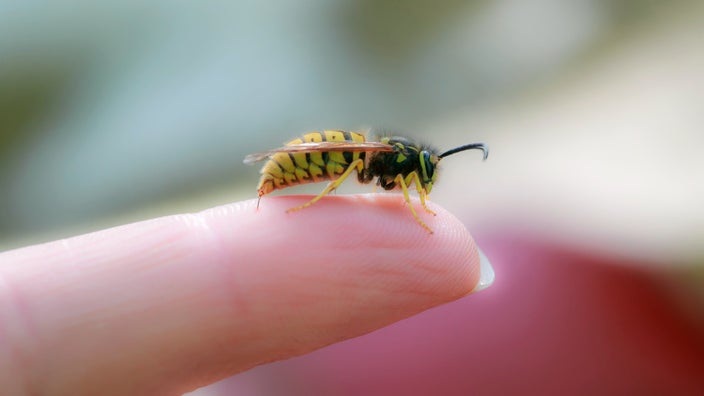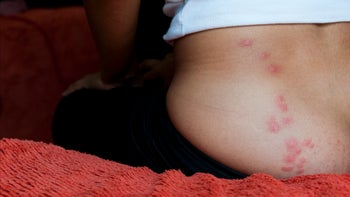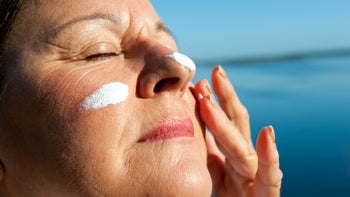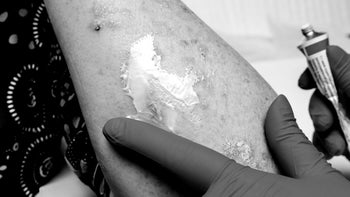
Bee Sting Treatment: Step-by-Step Self-Care Instructions
Key takeaways:
Stings from bees, hornets, and wasps can be a nuisance, especially in the warm months. Most of the time, you can take care of these at home with ice and over-the-counter (OTC) medications.
The best way to treat a bee sting is to remove the stinger, apply ice, and use OTC treatments for any pain or irritation.
Seek immediate medical attention if you experience any symptoms of an allergic reaction. Signs of a severe reaction include hives, trouble breathing, and swelling of the lips or mouth.
Table of contents

Bugs with stingers — like bees, wasps, hornets, and ants — belong to a group of insects called Hymenoptera. There are over 130,000 species of Hymenoptera, and most people experience a sting at some point in their lives. For many, it causes irritation, swelling, and redness. But for a small number of people, the reaction can be more severe.
Whether you’ve had a bee sting before, it’s helpful to know the best ways to treat a sting. We’ll walk you through the steps to care for a bee or wasp sting and how to tell if you have a more serious reaction.
How to treat a bee sting
In the moments right after a sting, it can be hard to remember what to do next. Here are the immediate steps you can take.
Search and compare options
Stay calm
This can be harder than it seems, especially because stings tend to be quick and unexpected. So, pause for a moment to take a deep breath. This will allow you to take care of yourself or someone else.
Remove the stinger
Sometimes bees leave their stingers behind — this isn’t the case with other Hymenoptera. If you see a small, black dot on the skin, this is likely the stinger. It may still have some venom. Use something like a credit card in a gentle, scraping fashion to remove it. This method keeps you from squeezing any remaining venom into the skin. For this reason, also avoid using tweezers to remove it.
Apply ice
An ice pack on the area can help with pain and to reduce swelling. Don’t use the ice pack for more than 20 minutes each hour. This protects your skin from cold injury.
Over-the-counter medication
Over-the-counter (OTC) medications can help with the pain, itching, and swelling. These include:
Antihistamines: A dose of an antihistamine, such as diphenhydramine (Benadryl), can help with itching and swelling.
Pain medications: A dose of ibuprofen (Advil, Motrin) or acetaminophen (Tylenol) can help relieve the pain.
Topical hydrocortisone: If you prefer not to take a pill, a corticosteroid cream, like hydrocortisone, can help with the swelling and itchiness.
Anaphylactic reactions: Bee stings can be serious or even fatal if they cause anaphylaxis. So it’s important to recognize the signs and know what to do.
Spider bites: If you don’t see the insect, it can sometimes be hard to know what kind of bite you have. Here are the signs of a spider bite and when to get treatment.
Itchy bug bites: Bee stings can become itchy, like a mosquito bite. But there are ways to alleviate the itching at home.
Common symptoms of a bee sting
Most people recognize the moment they’re stung — and which insect did it. Other times, especially with a child, you may only see the reaction afterward. The typical skin reaction includes:
Pain: Stings of bees, wasps, and hornets tend to cause pain immediately.
Swelling: There may be swelling and redness to the area around the sting.
Warmth: The site of the sting may feel warm to the touch.
Itchiness: Stings from ants can be particularly itchy.
Bleeding: Sometimes the stinger can go deep enough to cause mild bleeding.
These symptoms develop within a few minutes and can last for a few days.
Read more like this
Explore these related articles, suggested for readers like you.
Bee sting allergic reactions
It’s important to be able to tell the difference between expected skin irritation from a bee sting and an allergic reaction. Only about 5% of the population in the U.S. will have an allergic reaction. This is more likely if the person has been stung before.
Anaphylaxis
A severe allergic reaction, also called anaphylaxis, can be fatal. This usually happens quickly (within 10 or 15 minutes) after a sting. Symptoms of anaphylaxis can include:
Hives: These are usually large, itchy bumps on your skin.
Difficulty breathing: This often results in noisy breathing, rapid breaths, or wheezing. Your lips may also look pale or dusky.
Angioedema: Swelling can occur in your neck, face, mouth, lips, or throat.
Dizziness: You may feel faint or lightheaded — or even pass out.
Abdominal pain, vomiting, or diarrhea: Some people experience gastrointestinal symptoms — like abdominal cramping, nausea, vomiting, or even loose bowel movements.
If you or someone nearby has any of these symptoms, it’s a medical emergency. Call 911 or go to the emergency room (ER) immediately. Anaphylaxis is a life-threatening condition that can progress quickly.
If someone has a known allergy and an epinephrine injector (Epipen) on hand, use it immediately. If not, paramedics and ER healthcare professionals can give you lifesaving epinephrine. You may also need intravenous (IV) fluids and other medications to help treat the allergic reaction.
Large local reactions
Some people may not have full-blown anaphylaxis but still have a more extensive skin reaction to the sting. This kind of reactions will:
Be larger (the swelling is greater than 10 cm in diameter)
Last longer (the increased swelling means it can take up to 7 to 10 days for things to get better)
Have more redness and pain
These reactions may benefit from steroids. To help reduce symptoms, you can use a corticosteroid cream twice a day until the swelling gets better. If topical steroids aren’t doing the trick, large reactions may need prescription steroids. But this isn’t common.
Treatment for multiple bee stings
Occasionally, if bees are particularly aggressive (“killer bees”), you may be swarmed. In this unlikely event, you may be stung several times. When this happens, the venom can cause symptoms throughout your whole body (rather than just at the site of the sting). Symptoms from many stings can include:
The reaction depends on the number of stings and the size of the person. Smaller people, like children, can have a more severe reaction. Usually, these symptoms don’t happen until there are more than eight stings per pound of body weight.
If you notice any of the above symptoms after a sting, go to an ER. You may need lab tests to make sure you’re OK. The care team can also give you IV fluids and medications to help you feel better.
Do home remedies for bee stings work?
There are a lot of claims about home remedies that supposedly help stings. But no studies show any of these methods help with the symptoms of stings.
The following home remedies are NOT recommended for self-care and can potentially be harmful:
Apple cider vinegar
Toothpaste
Tobacco paste
Pastes made with meat tenderizer and water
Rubbing alcohol may help keep the area clean and help prevent infection. But rubbing alcohol doesn’t help the sting itself get better.
When to see a healthcare professional
As mentioned above, you should go to an ER (not a regular healthcare professional’s office) if you’re experiencing symptoms of a severe reaction. These include:
Hives throughout the rest of your body, or hives that are progressing quickly
Difficulty breathing
Swelling around your neck, face, mouth, lips, or throat
Dizziness or loss of consciousness
Abdominal pain, vomiting, or diarrhea
Muscle or body aches
Dark urine
Abnormal bleeding or bruising
You should also see your regular primary care provider if you experience the following symptoms:
Swelling that is increasing from day to day, or exceeds 10 cm
New or increasing redness
Pain that is increasing, or seems to be out of proportion to a bee sting
Fever
Symptoms that aren’t improving after a week
These could all be signs of a more severe reaction that may benefit from steroids. Or they can be signs of a developing infection at the site of the sting, which may need antibiotics.
Frequently asked questions
Bees sting humans to protect their hive or when they’re provoked. So if you accidentally come too close or step on a hive, they’ll sting you to protect it. If they’re further from the hive and collecting pollen, they’ll only sting you if you aggravate them. For example, if you swat at them, hit them, or step on them.
Not all bee stings need to be treated. If you’re experiencing a normal reaction to a bee sting — like immediate pain, swelling or redness in the area of the sting, or itching — these symptoms are bothersome but don’t require treatment. They’ll go away on their own. You only need treatment if you have an allergic reaction, larger or more severe symptoms than normal, or multiple bee stings.
Aloe vera may be helpful for a bee sting. It has some anti-inflammatory properties, which may help with the redness and swelling. It’s cool and soothing effects can help alleviate warmth and itching. But you don’t need to use aloe for a bee sting. Other home remedies and OTC treatments that you have on hand will work just fine.
You shouldn’t massage a bee sting. If the stinger remains in the skin, this could increase the amount of venom injected into the skin. Even if the stinger is gone, massaging can increase the inflammation in the area and worsen the redness and swelling. Instead, you should apply a cold compress and try to avoid itching or touching the area.
The bottom line
For most people, a bee or wasp sting results in a small, painful reaction that lasts hours to days. You can take care of these reactions at home with a few easy tips. If you notice a large skin reaction or any other symptoms in your body, see a healthcare professional. You may need more treatment to recover from the sting. And most importantly, if you or a loved one experiences symptoms of anaphylaxis, don’t wait. Call 911 right away.
Why trust our experts?


References
Bee Aware. (n.d.). How common is a bee sting allergy?
Erickson, T. B., et al. (2017). Arthropod envenomation in North America. Emergency Medicine Clinics of North America.
Everson, G. W. (2014). Hymenoptera. Encyclopedia of Toxicology.
Rahmani, A. H., et al. (2015). Aloe vera: Potential candidate in health management via modulation of biological activities. Pharmacognosy Review.
Smithsonian. (n.d.). Africanized bees.





























